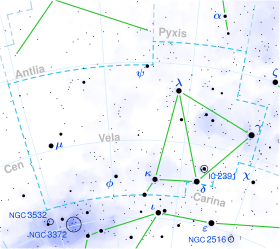Κ Velorum
| Observation data Epoch J2000 Equinox J2000 |
|
|---|---|
| Constellation | Vela |
| Right ascension | 09h 22m 06.81761s |
| Declination | –55° 00′ 38.4017″ |
| Apparent magnitude (V) | 2.48 |
| Characteristics | |
| Spectral type | B2 IV |
| U−B color index | –0.78 |
| B−V color index | –0.20 |
| Astrometry | |
| Radial velocity (Rv) | 21.9 km/s |
| Proper motion (μ) |
RA: –11.40 mas/yr Dec.: +11.52 mas/yr |
| Parallax (π) | 5.70 ± 0.30mas |
| Distance | 570 ± 30 ly (175 ± 9 pc) |
| Orbit | |
| Period (P) | 116.65 days |
| Eccentricity (e) | 0.19 |
|
Semi-amplitude (K1) (primary) |
46.5 km/s |
| Other designations | |
| Database references | |
| SIMBAD | data |
Kappa Velorum (κ Vel, κ Velorum) is a binary star system in the southern constellation of Vela. It has the traditional name Markab, from the Arabic مركب, markab meaning "something to ride". It is often spelled Markeb to distinguish it from similarly named stars such as Alpha Pegasi.
From parallax measurements, this system is located at a distance of roughly 572 light-years (175 parsecs) from the Earth. The apparent visual magnitude is 2.48, making it readily visible to the naked eye in the southern hemisphere.
This is a spectroscopic binary system consisting of a pair of stars that complete an orbit around each other with a period of 116.65 days and an orbital eccentricity of 0.19. Because the individual stars have not been resolved, further details of the orbit have not yet been determined. The combined stellar classification of the pair is B2 IV, which matches the class of a B-type subgiant star that has exhausted the hydrogen at its core and begun to evolve into a giant. It has an estimated size of 6.9 times the Sun's radius.
The star is only a couple of degrees from the south celestial pole of Mars, so it could therefore be considered the southern polar star of Mars. Due to precession of the equinoxes, it will be the closest bright star of note to the south celestial pole of Earth in the period surrounding 9000 AD. The False Cross is an asterism formed of the δ Velorum and κ Velorum and ι Carinae and ε Carinae. It is so called because it is sometimes mistaken for the Southern Cross, causing errors in astronavigation.
...
Wikipedia

